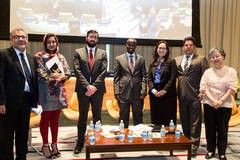
GCED Basic Search Form
Quick Search
Close
Vous êtes ici
Nouvelles
UN discusses innovative solutions to prevent violence extremism through education
Publié le:
2016/06/09

It is critical that young people experience positive values in a safe, open and inclusive learning environment to build their resilience against violent extremism. This was a key message at a UN roundtable discussion on the prevention of violent extremism at the United Nations headquarters, on Thursday 2 June, at UN Headquarters, in New York.
The discussion, organized by the UN Secretary-General Global Education First Initiative, in cooperation with the Permanent missions of the Principality of Andorra, the Republic of Korea and Tunisia to the United Nations, was part of an on-going dialogue for policy-makers, practitioners and researchers to share innovative solutions and exploring the role education can play in the different contexts where young people might be susceptible to movements and organizations promoting violent extremism.
“Global citizenship education is an entry point to respond to violence and extremism, as it equips youth with skills, values and knowledge to empower them as global citizens through the practice and promotion of tolerance, human rights, social justice and acceptance of diversity,” said Jorge Sequeira, Director of UNESCO Chile Field Office and UNESCO Representative to the cross-agency UN Counter-Terrorism Implementation Task Force, who moderated the discussion.
One of the key initiatives presented was UNESCO’s Teacher’s Guide for the Prevention of Violent Extremism published in May. The Teacher’s Guide provides practical advice and tips to teachers on how to discuss these issues in the classroom setting. ”Schools have to provide room for dialogue and not avoid “taboo” subjects”, said UNESCO Director of the Division for Inclusion, Peace and Sustainable Development and UNESCO’s focal point on education to prevent violent extremism Soo-Hyang Choi who presented the publication. Yet she stressed that education should not be looking at individuals but rather at the breeding grounds of violent extremism and radicalization.
Two UNESCO guidance tools on the prevention of violent extremism
This roundtable discussion comes at a useful juncture: following the presentation in January 2016 of the UN Secretary General’s launch of a Plan of Action to Prevent Violent Extremism and the development of two UNESCO guidance tools for teachers and education policy makers for the prevention of violent extremism.
Ms Choi also presented key recommendations of a Policy Guide on the prevention of violent extremism to be published later this year. For reducing the risk of youth turning to violent extremism, the following strategic approaches: revising of curricula to eliminate negative values and promote positive values; improving learning environment with particular attention to integration of all students; and fostering closer links with families and communities.
Both guides will be presented at the “International Conference on the Prevention of Violent Extremism: Taking Action” that will be organized by UNESCO in cooperation with Mahatma Gandhi Institute of Education for Peace and Sustainable Development in New Delhi, India, on 19 and 20 September 2016.
As a follow-up to the Conference, UNESCO will continue its work in this field through capacity-building activities of policy-makers and teachers in cooperation with its partners, notably the Asia-Pacific Centre of Education for International Understanding.
The discussion, organized by the UN Secretary-General Global Education First Initiative, in cooperation with the Permanent missions of the Principality of Andorra, the Republic of Korea and Tunisia to the United Nations, was part of an on-going dialogue for policy-makers, practitioners and researchers to share innovative solutions and exploring the role education can play in the different contexts where young people might be susceptible to movements and organizations promoting violent extremism.
“Global citizenship education is an entry point to respond to violence and extremism, as it equips youth with skills, values and knowledge to empower them as global citizens through the practice and promotion of tolerance, human rights, social justice and acceptance of diversity,” said Jorge Sequeira, Director of UNESCO Chile Field Office and UNESCO Representative to the cross-agency UN Counter-Terrorism Implementation Task Force, who moderated the discussion.
One of the key initiatives presented was UNESCO’s Teacher’s Guide for the Prevention of Violent Extremism published in May. The Teacher’s Guide provides practical advice and tips to teachers on how to discuss these issues in the classroom setting. ”Schools have to provide room for dialogue and not avoid “taboo” subjects”, said UNESCO Director of the Division for Inclusion, Peace and Sustainable Development and UNESCO’s focal point on education to prevent violent extremism Soo-Hyang Choi who presented the publication. Yet she stressed that education should not be looking at individuals but rather at the breeding grounds of violent extremism and radicalization.
Two UNESCO guidance tools on the prevention of violent extremism
This roundtable discussion comes at a useful juncture: following the presentation in January 2016 of the UN Secretary General’s launch of a Plan of Action to Prevent Violent Extremism and the development of two UNESCO guidance tools for teachers and education policy makers for the prevention of violent extremism.
Ms Choi also presented key recommendations of a Policy Guide on the prevention of violent extremism to be published later this year. For reducing the risk of youth turning to violent extremism, the following strategic approaches: revising of curricula to eliminate negative values and promote positive values; improving learning environment with particular attention to integration of all students; and fostering closer links with families and communities.
Both guides will be presented at the “International Conference on the Prevention of Violent Extremism: Taking Action” that will be organized by UNESCO in cooperation with Mahatma Gandhi Institute of Education for Peace and Sustainable Development in New Delhi, India, on 19 and 20 September 2016.
As a follow-up to the Conference, UNESCO will continue its work in this field through capacity-building activities of policy-makers and teachers in cooperation with its partners, notably the Asia-Pacific Centre of Education for International Understanding.
URL:
http://www.unesco.org/new/en/media-services/single-view/news/un_discusses_innovative_solutions_to_prevent_violence_extremism_through_education/#.V1YPvNmLSUk
